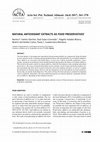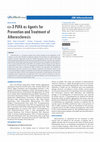Papers by Norma Francenia Santos Sánchez

Acta scientiarum polonorum. Technologia alimentaria
The food industry is becoming more specialized and processing methods are continuously being deve... more The food industry is becoming more specialized and processing methods are continuously being developed to meet consumer needs. Consumers demand products that are safe and preferably free of synthetic additives. These additives are associated with health effects, in most cases without reasonable justification. Consequently, consumers are looking for clearly labelled products that guarantee the absence of synthetic additives. This has led to the need to search for natural additives, which the food industry claims arenatural antioxidant preservatives. The sources of natural antioxidants can be extremely varied, because practically all plants contain antioxidants that allow them to protect themselves from solar radiation and pests, as well as to regulate the production of chemical energy. However, the best alternatives for the food industry are fruits and spices, because they are already foods themselves. This article will describe fruits and spices considered as important sources of ph...
Journal of Oleo Science
Introduction Coffee is an important food product for production economies and exporting countries... more Introduction Coffee is an important food product for production economies and exporting countries 1 , Oaxaca is the fourth largest producer in the Mexican Republic and received in 2020 the denomination of origin published in the Diario Oficial de la Federación DOF , the Pluma coffee is characterized by having a pleasant bouquet, exquisite flavor, accentuated acidity, excellent aroma, light body, whose attributes can be enhanced through roasting. Pluma coffee derives from the fruits of the coffee plants of the species C. arabica L., mainly from the var. Typica and var. L. Pluma Hidalgo, as well as var. Bourbon, var.
Journal of Natural Products, 1998
Magnetic resonance in chemistry : MRC, 2004
The extent to which conformational preferences of fused heterocyclic five-membered rings change w... more The extent to which conformational preferences of fused heterocyclic five-membered rings change with the nature of the heteroatom (O and S) was investigated in furo- (1, 2) and thieno[2,3-b]indolines (3, 4) by the combined use of 1H NMR spectroscopy and density functional theory (DFT) calculations. In contrast to the behavior observed for pyrroloindolines, the furo- and thienoindolines exist in solution in only one conformer, with structures in the 2E-2T3 (1,2) and 2T3-E (3,4) North/West region of the pseudorotational wheel, and with pseudorotation phase angles (P) of 315.8, 311.6, 337.2 and 331.6 degrees, respectively.

Molecules, 2021
Nacobbus aberrans ranks among the “top ten” plant-parasitic nematodes of phytosanitary importance... more Nacobbus aberrans ranks among the “top ten” plant-parasitic nematodes of phytosanitary importance. It causes significant losses in commercial interest crops in America and is a potential risk in the European Union. The nematicidal and phytotoxic activities of seven plant extracts against N. aberrans and Solanum lycopersicum were evaluated in vitro, respectively. The chemical nature of three nematicidal extracts (EC50,48h ≤ 113 µg mL−1) was studied through NMR analysis. Plant extracts showed nematicidal activity on second-stage juveniles (J2): (≥87%) at 1000 µg mL−1 after 72 h, and their EC50 values were 71.4–468.1 and 31.5–299.8 µg mL−1 after 24 and 48 h, respectively. Extracts with the best nematicidal potential (EC50,48h < 113 µg mL−1) were those from Adenophyllum aurantium, Alloispermum integrifolium, and Tournefortia densiflora, which inhibited L. esculentum seed growth by 100% at 20 µg mL−1. Stigmasterol (1), β-sitosterol (2), and α-terthienyl (3) were identified from A. aur...
Pharmacognosy Reviews, 2021

Applied Microbiology and Biotechnology, 2016
Despite microalgae recently receiving enormous attention as a potential source of biodiesel, thei... more Despite microalgae recently receiving enormous attention as a potential source of biodiesel, their use is still not feasible as an alternative to fossil fuels. Recently, interest in microalgae has focused on the production of bioactive compounds such as polyunsaturated fatty acids (PUFA), which provide microalgae a high added value. Several considerations need to be assessed for optimizing PUFA production from microalgae. Firstly, a microalgae species that produces high PUFA concentrations should be selected, such as Nannochloropsis gaditana, Isochrysis galbana, Phaeodactylum tricornutum, and Crypthecodinium cohnii, with marine species gaining more attention than do freshwater species. Closed cultivation processes, e.g., photobioreactors, are the most appropriate since temperature, pH, and nutrients can be controlled. An airlift column with LEDs or optical fibers to distribute photons into the culture media can be used at small scale to produce inoculum, while tubular and flat panels are used at commercial scale. Depending on the microalgae, a temperature range from 15 to 28 °C and a pH from 7 to 8 can be employed. Relevant conditions for PUFA production are medium light irradiances (50-300 μmol photons m(-2) s(-1)), air enriched with (0-1 % (v/v) CO2, as well as nitrogen and phosphorous limitation. For research purposes, the most appropriate medium for PUFA production is Bold&#39;s Basal, whereas mixotrophic cultivation using sucrose or glucose as the carbon source has been reported for industrial processes. For cell harvesting, the use of tangential flow membrane filtration or disk stack centrifugation is advisable at commercial scale. Current researches on PUFA extraction have focused on the use of organic solvents assisted with ultrasound or microwaves, supercritical fluids, and electroporation or are enzyme assisted. Commercial-scale extraction involves mainly physical methods such as bead mills and expeller presses. All these factors should be taken into account when choosing a PUFA production system, as discussed in this review.

Frontiers in Microbiology, 2014
The antimicrobial activity of 12 plant extracts was tested against the phytopathogens Alternaria ... more The antimicrobial activity of 12 plant extracts was tested against the phytopathogens Alternaria alternata and Fusarium solani. In addition, the compatibility of the extracts toward Bacillus liqueniformis, a biofertilizer and a non-target microorganism, was assessed. Plants tested belong to the Euphorbiaceae, Asteraceae, Crassulaceae, Rubiaceae, Convolvulaceae, Verbenaceae, Orchidaceae, Nyctaginaceae, Boraginaceae, and Tiliaecae families and were collected in the State of Oaxaca. The antifungal activity of the plant extracts (50-100 mg/mL) against A. alternata and F. solani, was determined by measuring the mycelium radial growth and obtaining the minimum inhibitory concentration (MIC) of fungal growth. In addition, with the aim of finding plant extracts which are compatible with a B. licheniformis biofertilizer strain and to test the non-toxic nature of the treatments, the toxicity of the extracts toward this strain was evaluated using the agar diffusion method. Azoxystrobin (12 μg) and chloramphenicol (30 μg) were used as positive controls for the pathogens and for the non-target bacteria, respectively. Plant extracts inhibited fungal growth in the ranges of 0.76-56.17% against F. solani and 2.02-69.07% against A. alternata. The extracts of Acalypha subviscida, Ipomoea murucoides, Tournefortia densiflora and Lantana achyranthifolia showed MIC values between 5.77-12.5 mg/mL for at least one of the fungal species. The best treatment, Adenophyllum aurantium, exhibited a maximum inhibition for both F. solani (56.17%, MIC = 7.78 mg/mL) and A. alternata (68.64% MIC = 7.78 mg/mL), and resulted innocuous toward B. licheniformis. Therefore, this plant has an outstanding potential for the agroecological control of fungal phytopathogens in industrial crops.
Acta Crystallographica Section E Structure Reports Online, 2007
data_I # rsalas in P 21/n New: P21/c _audit_creation_date 07-08-10 _audit_creation_method CRYSTAL... more data_I # rsalas in P 21/n New: P21/c _audit_creation_date 07-08-10 _audit_creation_method CRYSTALS _cell_length_a 7.3899(2) _cell_angle_alpha 90 _cell_length_b 12.2135(3) _cell_angle_beta 119.7260(10) _cell_length_c 12.2633(3) _cell_angle_gamma 90 # NOTE Fc ...
Una aproximación a la espectroscopía de Resonancia Magnética Nuclear
El presente capítulo consiste en una compilación de los resúmenes de 15 conferencias presentadas ... more El presente capítulo consiste en una compilación de los resúmenes de 15 conferencias presentadas de forma virtual en la 6ª Reunión de Resonancia Magnética Nuclear organizada por la Universidad Tecnológica de la Mixteca y la Sociedad Mexicana de Resonancia Magnética Nuclear. Con la participación de conferenciantes nacionales e internacionales. Los conferenciantes internacionales son ampliamente reconocidos en el ámbito de la RMN. Los temas abordados en las conferencias fueron la química de proteínas, química de productos naturales, química de materiales, química de alimentos, RMN del estado sólido y desarrollo de nuevos métodos para el estudio de macromoléculas en disolución.

Una aproximación a la espectroscopía de Resonancia Magnética Nuclear
La espectroscopía de RMN es una técnica poderosa para el estudio de propiedades y composición de ... more La espectroscopía de RMN es una técnica poderosa para el estudio de propiedades y composición de alimentos y plantas. Las propiedades pueden estudiarse a través de experimentos de RMN en el dominio del tiempo. Mientras que el estudio de la composición y cuantificación de metabolitos se puede llevar a cabo a partir experimentos de RMN en el dominio de la frecuencia. Esto se puede lograr a partir de dos enfoques generales. El primero consiste en adquirir las huellas dactilares de metabolitos a partir de un análisis multivariante de datos de RMN en 1D y 2D ya sea en el dominio del tiempo o frecuencia. La adquisición de huellas dactilares por RMN suele ser una herramienta rápida y eficaz para discriminar entre grupos de muestras relacionadas a partir de la identificación de las regiones espectrales más distintivas. Un segundo enfoque consiste en realizar perfiles de metabolitos con los espectros de RMN, principalmente de 1H, a partir de extractos de muestras. Esto normalmente permite id...

Medwave, 2020
El sindrome respiratorio agudo severo coronavirus 2 (SARS-CoV-2) es responsable de la enfermedad ... more El sindrome respiratorio agudo severo coronavirus 2 (SARS-CoV-2) es responsable de la enfermedad denominada COVID-19 (acronimo del ingles Coronavirus Disease-2019). Esta enfermedad fue detectada inicialmente en la ciudad de Wuhan, China en diciembre de 2019. Las personas contagiadas con COVID-19 presentan sintomas variados, dependiendo de su estado de salud y edad. Los sintomas mas comunes son fiebre, tos, mialgia, fatiga, odinofagia y disnea. Tambien se ha observado que en algunos pacientes, la infeccion es asintomatica. Los adultos mayores de 60 anos infectados son el grupo de pacientes mas susceptibles a desarrollar estados severos de COVID-19 y se presenta comorbilidad en presencia de enfermedades cronicas. Por otra parte, tambien es importante disponer de pruebas que permitan detectar al SARS-COV-2 y seguir la evolucion de COVID-19 de forma rapida, confiable y barata. Para lograr esto, existen pruebas de reaccion en cadena de la polimerasa de transcripcion inversa en tiempo rea...

Acta scientiarum polonorum. Technologia alimentaria, 2020
BACKGROUND le tree (Sideroxylon palmeri) belongs to family Sapotaceae, and its fruits contain hyd... more BACKGROUND le tree (Sideroxylon palmeri) belongs to family Sapotaceae, and its fruits contain hydrophilic and hydrophobic gums. Aim of this study was to develop an extraction method for pectin, a hydrophilic gum, from green and ripe tempesquistle fruit. The extraction method was gentle to minimize potential structural changes in pectin, a maceration was used, and then pectin precipitation was induced with acetone at room temperature. Pectin characterization was carried out in two steps. The first step consisted of qualitative tests of Molisch, Fehling and Lugol. The second step consisted of quantitative tests to determine esterification degree (ED) by ATR-FTIR and D-galacturonic acid (D-GalA) content with a colorimetric assay. ATR-FTIR spectroscopic method revealed that green and ripe tempesquistle fruit have an ED of 0% and 30.4%, respectively. Both fruit have a low ED pectin. The content of D-GalA in green and ripe pectins was 18.8 ±2.7% and 20.2 ±0.6%, respectively. The yield obt...

Atherosclerosis is a progressive disease that involves damage to the endothelium of the arteries,... more Atherosclerosis is a progressive disease that involves damage to the endothelium of the arteries, as well as the formation of atheroma plaques. The risk factors for atherosclerosis are unknown. However, high levels of LDL (Low Density Lipoprotein) and low levels of HDL (High Density Lipoprotein) cholesterol in the blood can encourage this disease. It has also been reported that patients with diabetes, hypertension and obesity may be more susceptible to atherosclerosis. The ω-3 polyunsaturated fatty acids (PUFA) are essential to human beings and are taken at concentrations of about 3 g day-1 for atherosclerosis prevention and treatment. Meta-analysis studies have been used to evaluate the effect of PUFA in the prevention and treatment of atherosclerosis and have proven to be an effective treatment of the disease, whereas in the case of prevention the results are inconclusive. This has led to the development of in vivo methods to quantify the effect of PUFA in the treatment and preven...
The study objective was to evaluate effect of mango-seed extract alone or in combination with sod... more The study objective was to evaluate effect of mango-seed extract alone or in combination with sodium metabisulphite on the content of vitamin C, free phenols, six phenols compounds, and total carotenes, and color in mango slices dried at 60oC until 15% moisture. From drying curves were calculated effective diffusivities [1.17-1.35x10-9 m2•s-1] and drying rate constants [1.53±0.90x10-3-2.27±0.80x10-3] using Midilli’s model. Results showed that combination of mango-seed extract with sodium metabisulphite has an important role in retention of vitamin C and carotenes, and an enrichment of phenolic compounds was found in dried mango slices.

Medwave
Severe Acute Respiratory Syndrome Coronavirus 2 (SARS-CoV-2) causes COVID-19 (Coronavirus disease... more Severe Acute Respiratory Syndrome Coronavirus 2 (SARS-CoV-2) causes COVID-19 (Coronavirus disease 2019). This disease was detected in the city of Wuhan in China in December 2019. People infected with COVID-19 shows varying manifestations, depending on their health and age. The most common symptoms are fever, cough, myalgia, fatigue, odynophagia, and dyspnea. Infected adults older 60 years of age are the group of patients most susceptible to severe COVID-19 states and present comor-bidity in the presence of chronic diseases. On the other hand, it is also essential to have tests to detect SARS-COV-2 in people and follow the evolution of COVID-19 quickly, reliably, and cheap. To achieve this, there are real-time reverse transcription pol-ymerase chain reaction (RT-PCR) tests, isothermal nucleic acid amplification, and enzyme immunostimulation. Currently, there are no drug treatments to prevent infection and to combat the virus's effects. However, different research groups that are conduct-ing in vitro, in vivo, and in silico tests to find drugs able to provide an immune response and to control infection in humans with SARS-CoV-2. Chloroquine, hydroxychloroquine, remdesivir, interferon-2b, and oseltamivir are some pharmacological options evaluated in clinical trials for prophylaxis of COVID-19. The purpose of this review is to establish a reference framework for taxonomic classification of SARS-CoV-2 and the relationship they have with other CoVs, as well as their structure and propaga-tion pathways in humans. The characteristics and symptoms presented by patients with COVID-19, the detection methods, and possible treatments are also presented.

Antioxidants, Nov 6, 2019
An antioxidant is a substance that at low concentrations delays or prevents oxidation of a substr... more An antioxidant is a substance that at low concentrations delays or prevents oxidation of a substrate. Antioxidant compounds act through several chemical mechanisms: hydrogen atom transfer (HAT), single electron transfer (SET), and the ability to chelate transition metals. The importance of antioxidant mechanisms is to understand the biological meaning of antioxidants, their possible uses, their production by organic synthesis or biotechnological methods, or for the standardization of the determination of antioxidant activity. In general, antioxidant molecules can react either by multiple mechanisms or by a predominant mechanism. The chemical structure of the antioxidant substance allows understanding of the antioxidant reaction mechanism. This chapter reviews the in vitro antioxidant reaction mechanisms of organic compounds polyphenols, carotenoids, and vitamins C against free radicals (FR) and prooxidant compounds under diverse conditions, as well as the most commonly used methods to evaluate the antioxidant activity of these compounds according to the mechanism involved in the reaction with free radicals and the methods of in vitro antioxidant evaluation that are used frequently depending on the reaction mechanism of the antioxidant.

Antioxidants in Foods and Its Applications, Jul 11, 2018
Species of the genus Annona (Annonaceae) are distributed in the tropical and subtropical regions ... more Species of the genus Annona (Annonaceae) are distributed in the tropical and subtropical regions of the world and are characterized by their highly valued exotic fruit. The commercial species are A. muricata, A. crassiflora, A. squamosa, A. cherimola, and A. reticulata. In addition, different parts of the tree, including leaf, bark, and roots, are used in traditional medicine to treat conditions such as diabetes, hypercholesterolemia, hypertension, cancer, and gastrointestinal diseases. Phytochemical studies are helping to determine the biological properties of extracts and characterize bioactive principles from extracts of genus Annona. The main chemical compounds isolated from genus Annona are phenols, acetogenins, alkaloids, and cyclopeptides. All these compounds have antioxidant properties and generally are associated with other biological properties. The aim of this chapter is to carry out an analysis of the properties related to combating oxidative stress of the five most important species of the genus Annona, as well as the relationship these properties have with the bioactive principles present in these plants.

Uploads
Papers by Norma Francenia Santos Sánchez